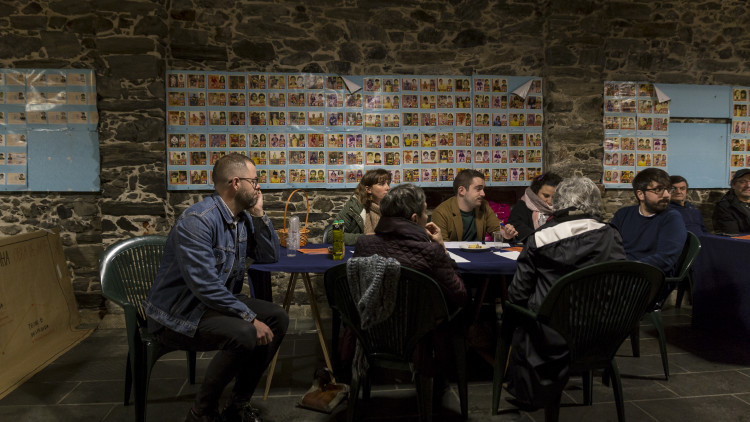Mediation, Care and Other Common Places

Lorena Ruiz
Some words open worlds. In recent years, “care” has opened up many realms that surround and make us: interdependence, vulnerability, fragility, collective support, and mutual support networks.
Some worlds open words. Care brings with it the vocabulary of warmth, humanity, goodness, the maternal and desirable. However, these idealised visions have been challenged from many fronts—particularly feminism—, which have highlighted the complex nature of care. So the conversation has turned to inequalities, conflicts, and power dynamics, placing gender issues and gender-based demands at the centre of the debate.
Words and worlds. Imaginaries and practices. Semiotics and materiality intertwining in the day-to-day experience of care.
Words and worlds in turn lead us to other words and worlds, inevitable links in a chain. Something of this kind has been happening recently in the cultural sphere, with the link between care and mediation. These two words—and their respective worlds— are increasingly turning towards each other, growing closer. Cultural mediation— understood as a form of care—involves a situated practice that revolves around openness, observation, and listening. And mediation, like care, is also complex: both have contradictions, conflicts, and a sticky, slippery side. Mediation and care are uncertain processes, incomplete mechanisms that require the involvement of the other to become useful and meaningful.
“Mediation does not merely connect people, ideas, worlds, and lives (both symbolically and materially). Rather, its main purpose is to sustain those connections, to help them endure for as long as they are meaningful to those who inhabit them. Mediation sparks conversations, turns its attention to the things that affect and trouble us. It is a radar that picks up the particularities, desires, needs, and strengths of communities.”
Philosopher and mediator Juan Gutiérrez describes mediation as the art of making a common place. Thus, in order for a place to become a common place, work must be done—someone has to look after it. And this work is an art: cooked on low heat, lovingly, with its own language, difficult to pin down. It is artisanal.
The projects carried out as part of Concomitentes are based on an assemblage of mediation and care: mediators and citizen-commissioners slowly define a commission, which the artists will then carry out. If we move away from the idea of mediation as “being between” (between two groups, between two people, between two approaches) and begin understanding mediation as the art of connection, then the place that appears before us could be a common place.
Naturally, the Concomitancias are committed to becoming common places. However, if listening is a key component of this situated mediation: are we listening to those we accompany? Do we ask those receiving our care how they want to be cared for? Are there spaces—and times—in which to talk about it? If not, how can we create them?
“Communication between mediators and citizen-commissioners is key in this regard. But perhaps we should consider broadening the possible categories of dialogue and listening: de-emphasise the discursive, intellectual, and even rational focus and explore forms of co-creation—artistic, cultural, material—that allow us to listen to each other and think collectively, through doing.”
The hacker mentality provides some touchstones to guide these mediation practices. Firstly, use a distributed approach and open up processes, so that mediators are just a node in the network, decentralising connections. Secondly, tinker and mess around, reclaiming trial and error—anyone who has children or works with children knows that fixes and experiments are a fundamental part of care. This approach also inevitably requires a form of mediation based on accompaniment: walking with others, recognising and accepting their pace, waiting, sometimes taking a break to allow things to happen—or to happen on their own terms—avoiding as far as possible the fetishism of intervention and methodology. A kind of accompaniment in which we only open up what we can take on. That is another form of care.
When we care for people, it is important to ask them how they would like to be cared for. When an artist is being commissioned, it is important to ask the citizen-commissioners how they would like it to be. But we have to go one step further: what are we going to do with what they tell us? where will we put what they say? what will we connect it to? Can we take on everything we hear? What do we do with the pointy bits of representation—the speaking on behalf of—? Caring is not just about listening. It is also, and especially, about what we do—and don’t do—with what we hear. It is about taking responsibility for what we hear, sustaining it. And it is also about not being able to care, protecting connections by accepting our limits and the limits of the situation.
Mediation is the joint exploration of what we know, what we want, and what we are capable of. This requires an attitude of care based on listening and honesty: we have to talk about the awkward aspects, recognising what has been done and what hasn’t been done. And why. Then we will be able to imagine other common places, other tools with which to make them, and other alliances for maintaining them.
Sources:
Padilla, Margarita (2012). El kit de la lucha en internet. Madrid: Traficantes de Sueños.
Fernández-Savater, Amador (2012). “El 15-M y la crisis de la cultura consensual en España” in Periférica Internacional. Revista para el análisis de la cultura y el territorio, 13, 63-71.
